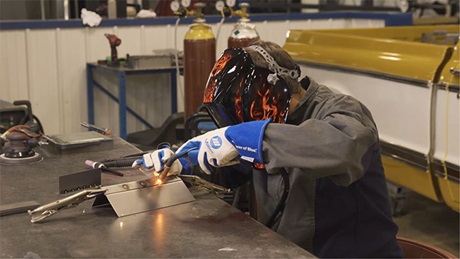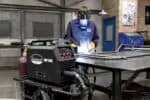Professional welders who work sheet metal are always in high demand because working and welding sheet metal is an art that requires lots of experience and years of practice. Theoretically, it may appear relatively simple, but it’s an entirely different story once the welder is in your hands.
While there are numerous MIG, TIG, flux-core, and laser welders available for purchase in the marketplace, it’s a challenge to find a welder that best suits your projects. That’s where we come in. We’ve researched and tested numerous welders for you, to save you some time and money.
If you are a newbie to welding, but passionate about working with sheet metal, your first step will be purchasing the proper equipment, so you can get to work practicing and acquiring the necessary skills.
To aid you in getting the best welder for sheet metal, we looked for welders that are efficient and functional with comfortable duty cycles and features to assist you in your projects.
Our overall pick is the Forney Easy Weld Multi-Function 140MP because is a multiprocess welding machine great for hobbyists and beginners. You can do TIG, MIG, and Stick applications with the same machine. This is a very versatile welding machine.
However, we also like the Hobart Handler 500559 140 MIG Welder, because we found it convincing due to the fact that it’s a high-quality machine at a price that is budget-friendly.
| Product | Amperage | Voltage | Duty Cycle | Application |
|---|---|---|---|---|
| Forney Easy Weld Multi-Function 140MP | 10 to 140A | 110V | MIG 30%@90A; TIG 30%@110A; Stick 30%@80A | MIG, TIG, Stick Welding |
| Primeweld 225A IGBT TIG225X AC/DC TIG-Stick Welder | 10 to 225A | AC/DC 110/220V | 120V: 40%@140A, 100%@108A; 240V: 40%@225A, 100%@155A | TIG, Stick Welding |
| Hobart Handler 500558 140 MIG Welder | 25 to 140A | 115V | 20%@90A | MIG, Flux Core welding |
Our Favorite Best Welders for Welding Sheet Metal
Best Overall Welder for Sheet Metal
1. Forney Easy Weld Multi-Function 140MP
- MULTI-PROCESS WELDER
- EASY TO USE
- CONTROL YOUR WELD
- RUGGED
Prices pulled from the Amazon Product Advertising API on:
Product prices and availability are accurate as of the date/time indicated and are subject to change. Any price and availability information displayed on [relevant Amazon Site(s), as applicable] at the time of purchase will apply to the purchase of this product.
This is a multiprocess welding machine that makes it ideal especially for hobbyists and beginners. It boasts a sturdy build and permits you to effect TIG, MIG, and Stick applications with the same machine. This is a very versatile welding machine.
The 3-1 welding method allows you to work on thinner sheet metals without sacrificing other more appropriate applications for thicker materials.
The machine interface is easy and convenient to use permitting you to switch quickly among applications and easy-to-use knobs let you control the output without difficulty.
Features:
-
-
- MIG, TIG, Stick Welding
- 110V
- 10 to 140 Amps
- Duty cycle MIG 30%@90A; TIG 30%@110A; Stick 30%@80A
-
Pros
-
-
- 3 in 1 multi-process welding machine
- Easy-to-use interface
- A three-way switch for welding method changes
- Easy knob control of output
- More affordable than other welding machines
-
Cons
-
-
- Does not come with the necessary TIG accessories
- The duty cycle is a bit shorter compared to other machines
-
Best TIG Welder for Sheet Metal
2. Primeweld 225A IGBT TIG225X AC/DC TIG-Stick Welder
- 200HRTZ on PULSE FREQ AND AC FREQ will do 1/4 aluminum and 3/8 mild steel and 110/220 volts and is capable of welding 7018, 6013
- Both HF start hand torch control and precise foot pedal welding heat control
- Advanced Inverter Technology with PWM (Pulse Width Modulation) Using IGBT technology
Prices pulled from the Amazon Product Advertising API on:
Product prices and availability are accurate as of the date/time indicated and are subject to change. Any price and availability information displayed on [relevant Amazon Site(s), as applicable] at the time of purchase will apply to the purchase of this product.
This is a fantastic option for welding sheet metal as it is a TIG welding machine with an ample range of settings and it features both AC and DC power output for versatility.
It boasts a CK Superflex torch that is air-cooled and produces excellent welds at low amperage.
Featuring a foot pedal that is easier to use than a classic foot pedal, this welder boasts an ample amperage capability at a reasonable price considering all that it offers.
Primeweld also guarantees exceptional customer service, so you’ll always have assistance when needed.
Features:
-
-
- Foot pedal control
- TIG, Stick Welding
- AC DC, 110/220V
- 10 to 225 Amps
- Duty cycle 120V: 40%@140A, 100%@108A; 240V: 40%@225A, 100%@155A
-
Pros
-
-
- High-frequency start
- Pulse arc
- Low amperage capability
- AC and DC
- Finger switch and foot pedal
- Functions for up-slope and down-slope
-
Cons
-
-
- The foot pedal is not comfortable during use
-
Best MIG Welder for Sheet Metal
3. Hobart Handler 500559 140 MIG Welder
- 5-position voltage control selector adds a smooth, stable arc at all welding thicknesses
- Welds 24 gauge up to 1/4 in mild steel; Weldable Materials: Steel, Stainless Steel and Aluminum
- Welding Processes: MIG(GMAW), Flux Cored(FCAW)
- Operates off 115V standard household current; Wire Feed Speed Range 40-700 IPM, 50-740 IPM at no load
- Welding Amperage Range: 25-140 A; 20% duty cycle @ 90 Amps, 19V
Prices pulled from the Amazon Product Advertising API on:
Product prices and availability are accurate as of the date/time indicated and are subject to change. Any price and availability information displayed on [relevant Amazon Site(s), as applicable] at the time of purchase will apply to the purchase of this product.
Even if sheet metal welding is generally entrusted to TIG applications, a MIG welder can accomplish what you need. This MIG welder from manufacturer Hobart is affordable and more than satisfactory when it’s necessary to fuse sheet metal.
It’s a high-quality machine at a price that is budget-friendly. Although it does not boast an extensive amperage range, it does have what’s needed for sheet metal welding.
The Hobart Handler is easy-to-operate with very few settings and will create impressive beads for you. It performs well at very low amperages so you are not at risk of penetrating through a joint during your welding application.
Features
-
-
- 5 positions for voltage control
- MIG and Flux Core Welding
- 115V
- 25 to 140A
- Duty cycle 20%@90A
-
Pros:
-
-
- Quality machine
- Works at a low amperage
- Very easy to operate
- Budget-friendly
-
Cons
-
-
- The welding reference chart could be improved
-
So, how does one go about finding the appropriate welder for sheet metal? With so many choices, the task may appear daunting, but here are some of the things our team of pros suggests that you take into consideration.
Selecting the Best Sheet Metal Welder
Spending money on one of the most expensive options if you still need to acquire a certain level of skill. We all have different budgets, different projects, and different needs, so your first consideration should be what are you going to be welding.
Why do you need a welder? Will sheet metal be the only material that you plan on working with? And, last but not least, consider the space you have for a welder in your workshop.
Deciding the answers to these questions will make your task so much easier, and you can eliminate certain welders from the get-go.
What Makes Sheet Welding Different from Other Welding Applications?
Consider that sheet metal is exactly what the name implies, it is metal that comes in the form of a thin, flat sheet. Because of its thinness, it requires exceptional precision and skill to weld clean seamless joints.
In fact, MIG welders are generally recommended for sheet welding applications. Stick welders can be used up to a one-eighth-inch thickness, but only with the proper welder. Keep in mind that sheet metal thickness is usually specified in millimeters.
Welding Methods for Sheet Metal
As there is no specific machine just for sheet welding, this welding capability will be better served by certain welding methods. Welding thin metals can be very. Tricky, but different methods can get the job accomplished.
1. MIG Welding
MIG welding referred to as Metal Inert Gas Welding, is a method of arc welding. While it may appear easier than other methods, for example, TIG welding, it is quite a bit messier and may be more of a challenge when aiming for precision welds due to control.
Nonetheless, it is suitable for sheet metal welding and is a very popular method for this type of welding. Appropriate spools of wire must be selected for the sheet metal thickness together with the proper amperage to obtain a quality result.
2. Stick Welding
Also, an arc welding method, stick welding, or spot welding is a resistance welding method that isn’t ideal for welding sheet metals as it is very hot with penetration issues and is messy.
If you select a stick welder, it’s better to choose a multifunction machine. A bit of spot welding may work with sheet metals in specific circumstances like automotive repair or when joining or melding metal sheets together, but it is generally used with thicker metal pieces.
3. TIG Welding
Tungsten Inert Gas Welding, also known as TIG welding works very well with thinner metals and is much cleaner with much less slag produced.
This technique, however, requires quite a bit of skill and is more difficult to learn, because there are several simultaneous movements involved.
TIG welding literally has no rivals when it comes down to precision and control, as the welder can control what happens with the weld pool and the amount of heat involved. It’s a great option for welding thin metals.
Welder Features
Apart from personal taste, there will be some features that you need on your welder for working sheet metal. Here are some features that our team of welding pros gave us a heads up on when looking to purchase.
1. Welder Dimension and Weight
Whenever you select a power tool for a home workshop, it’s important to choose the correct size and weight for your workshop.
Consider the area within your workshop where you will be welding and the space you have available for your welder and welding activities.
2. Construction Material
When investing in a welder, durability should be a criterion so look for a machine with a solid construction, perhaps in steel which is an optimal choice for welders.
3. Duty Cycle
How long a welder can operate before needing to cool down is called the “duty cycle”. Duty cycles are generally calculated based on periods of ten minutes.
If a welder has a duty cycle of 30% at 60A, this indicates that the machine can run without interruption for three full minutes at 60 Amps before needing to rest and cool down for seven minutes.
4. Input Voltage
In the United States, the majority of electric appliances use 120V electricity to operate. If you plan on using a welder in your home workshop, it’s important to check if it can run on your home’s electrical system.
Some welders may run on dual voltage, or 120 and 240V. A welder that specifically runs on 240V will require you to rewire your workshop to handle the necessary voltage for operation.
5. Welding Wire
When considering welding wire, three types exist:
-
-
- Flux core wire
- Metal arc Solid gas welding wire
- Composite GMAW wire
-
Each type of wire will bring a distinct group of benefits along with a separate group of limitations. When welding sheet metal flux core wire is generally the wire of choice or solid wires because they aid control and are very versatile.
6. Included Accessories
The majority of welders sold currently do come with some added but important accessories. These may include a ground wire, an electrode holder, hoses, a welding gun, and other components that you will need.
If you are new to welding consider a package with everything you need to get started included in the package.
7. Extras
Some welders will come with extra features such as various welding capabilities like TIG, MIG, and Stick. Some will come with hot starts or thermal protection from overheating.
8. Warranty
Warranty may often seem like an afterthought but when it comes to any kind of power tool or appliance, a warranty is crucial.
If your welder malfunctions, it’s much better to receive a replacement or free repair thanks to a warranty than not.
Some manufacturers will offer five-year, three-year, or one-year warranties. Check to see if your warranty covers just replacement or repairs as well and to what extent.
9. Budget
Budget will always play an important role in defining what your options are. Before beginning your search, decide your price range to narrow down options and save precious time.
Conclusion
Whichever type of welding machine you choose, all three of these welding machines merit your consideration. Each offers both benefits and a few drawbacks, but they are all excellent machines.
The Forney welder is a 3-in-1 machine making it exceptionally versatile at an affordable price.
The Hobart Handler is a top MIG welder and the Primeweld 225X offers exceptional TIG welding capabilities. Whatever your preference or your project, you will not go wrong with any one of these welders.










